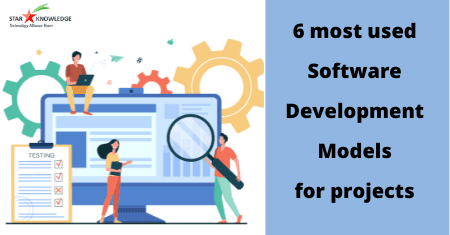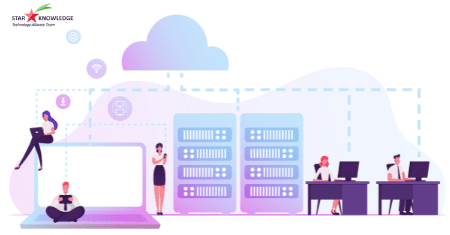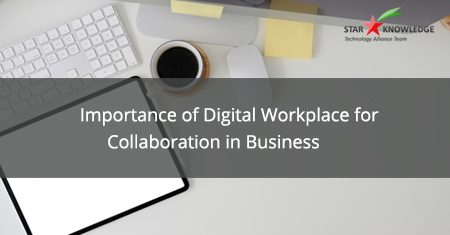
02 Jul Most Used Software Development Models for Projects
02 JuLY 2021

Software Development Life Cycle (SDLC) in the early phase of the development process from where the business requirements are realized and converted as functions and features of the software to achieve the needs. All Software Development models are selected based on the context of project requirements. Hence, one should know the importance of SDLC to choose and implement the best process to achieve the required objectives.
Different projects have varying requirements, timelines, and complexities, which call for specific development approaches. In this article, we will delve into the most popular software development models used by organizations worldwide. Understanding the key features, benefits, and limitations of each model will empower you to make an informed decision when selecting the appropriate approach for your software development project.
Top 6 Software Development Models
Waterfall Model
The Waterfall Model is one of the oldest and most traditional software development models. It follows a linear, sequential approach, where each phase of the development cycle flows downward like a waterfall. The typical phases include requirements gathering, design, implementation, testing, deployment, and maintenance.
The Waterfall Model is known for its structured and document-driven nature, making it suitable for projects with clear and well-defined requirements. It provides better visibility into project progress and is ideal for projects with fixed budgets and timelines. However, its rigidity can be a drawback when dealing with dynamic or evolving requirements, as it does not easily accommodate changes once a phase is completed.
The waterfall model contains:
- Requirement analysis
- Design
- Implementations
- Testing
- Deployment
- Maintenance
Prototype Model
The Prototype Model focuses on creating a working model or prototype of the software early in the development process. It allows stakeholders to visualize and provide feedback on the proposed solution before moving forward. The prototype helps identify and address potential issues, ensuring that the final product meets user expectations.
This model is beneficial when requirements are not fully understood or are likely to change during development. It facilitates effective communication between developers and stakeholders, reducing the risk of misunderstandings. However, the Prototype Model may incur additional costs and time if not managed efficiently, as iterations and revisions are inherent to the process.
This model allows customers to view and make changes in products before going live and this iteration is continued with the different sub-models until the product is satisfied:
- Rapid throwaway Prototype
- Evolutionary prototyping
- Incremental Prototyping
- Extreme prototyping
V Model
The V Model is one of the popular software development model. It is an extension of the Waterfall Model that emphasizes testing and verification. It establishes a strong correlation between each phase of the development cycle and its corresponding testing phase. The model follows a V-shaped structure, with the left side representing the development phases and the right side representing the testing phases.
By integrating testing early in the development process, the V Model ensures that defects are identified and addressed promptly. It promotes a comprehensive and systematic approach to quality assurance. However, like the Waterfall Model, the V Model may face challenges when it comes to adapting to changing requirements, as modifications in one phase can affect the subsequent phases.
Spiral Model
The Spiral Model combines elements of both waterfall and prototype models. It follows an iterative approach, allowing for incremental development and continuous risk analysis. The model revolves around four key activities: planning, risk analysis, engineering, and evaluation.
The Spiral Model is ideal for large and complex projects that require a high level of risk management and flexibility. It enables frequent prototyping and testing, which leads to early detection and mitigation of potential issues. However, the Spiral Model demands more resources, time, and expertise compared to other models, making it less suitable for small-scale projects with limited budgets.
Agile Model
The Agile Model is one of the most used software development models. It is flexible and iterative development approach that focuses on delivering working software in short iterations or sprints. It values collaboration, adaptability, and customer feedback. Agile methodologies like Scrum and Kanban are commonly used in Agile development.
The Agile Model promotes close collaboration between developers, stakeholders, and end-users, ensuring that the software meets evolving requirements and customer expectations. It embraces change and allows for continuous improvement throughout the project lifecycle. However, the Agile Model may pose challenges in terms of documentation and project visibility, requiring effective communication and project management practices.
Incremental Model
The Incremental Model is a software development approach that divides the project into small, manageable increments or modules. Each increment represents a partial system that delivers a specific set of functionalities. Development occurs in multiple iterations, with each iteration adding new features or functionality to the previous increment.
The Incremental Model allows for early delivery of working software and provides an opportunity for user feedback at each iteration. It enables faster time-to-market, as functionality can be released incrementally. This model is particularly suitable for projects with evolving requirements or when there is a need for regular updates and enhancements. However, proper planning and coordination are essential to ensure seamless integration of the increments and maintain overall system integrity.
Conclusion
Choosing the right software development model is crucial for project success. The Waterfall Model, Prototype Model, V Model, Spiral Model, and Agile Model each have their own strengths and weaknesses. The Waterfall Model provides a structured approach, while the Prototype Model allows for early feedback. The V Model emphasizes testing, and the Spiral Model focuses on risk management. The Agile Model offers flexibility and collaboration.
By understanding the key characteristics and considerations of each model, you can make an informed decision based on your project’s requirements, scope, timeline, and budget. Remember, there is no one-size-fits-all solution. Selecting the appropriate software development model will set the foundation for efficient and successful project execution, ensuring the delivery of high-quality software that meets your organization’s objectives.
Want to know the suitable model for your project? With expertise in software development, Star Knowledge provides solutions suitable for the business types by making them excel in their domain. Contact us today to know the solutions that are right for you.
Our Related Posts
Building your Intranet on SharePoint
With updated Office 365 features and modern SharePoint design and customization supported by SharePoint…
Employee HR portal to increase productivity in workplace
One of the common challenges faced by organizations is to provide their employees..
Building your Intranet on SharePoint
With updated Office 365 features and modern SharePoint design and customization supported by SharePoint, enterprises can create out-of-the-box intranet solution…




No Comments